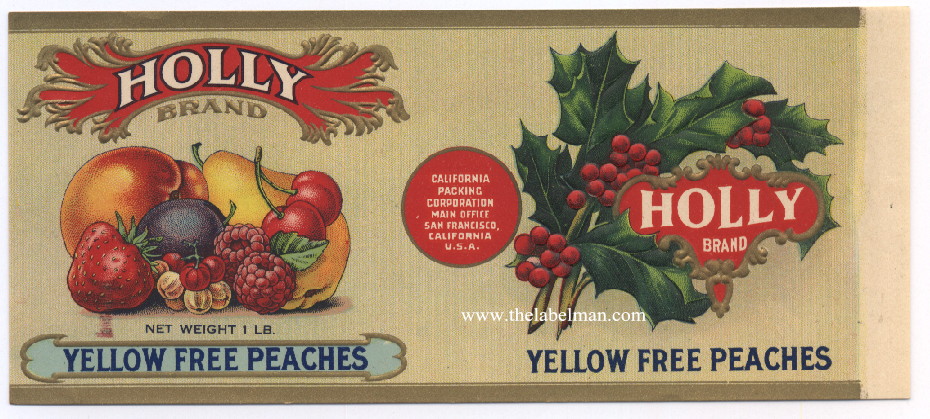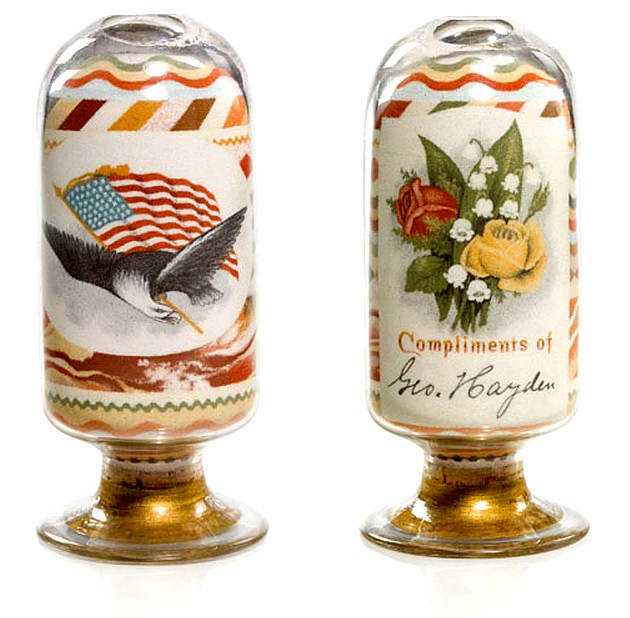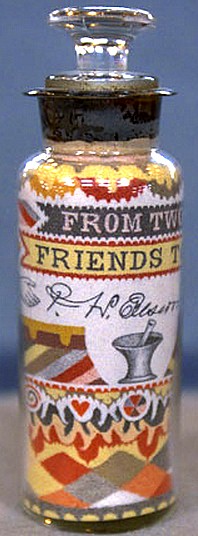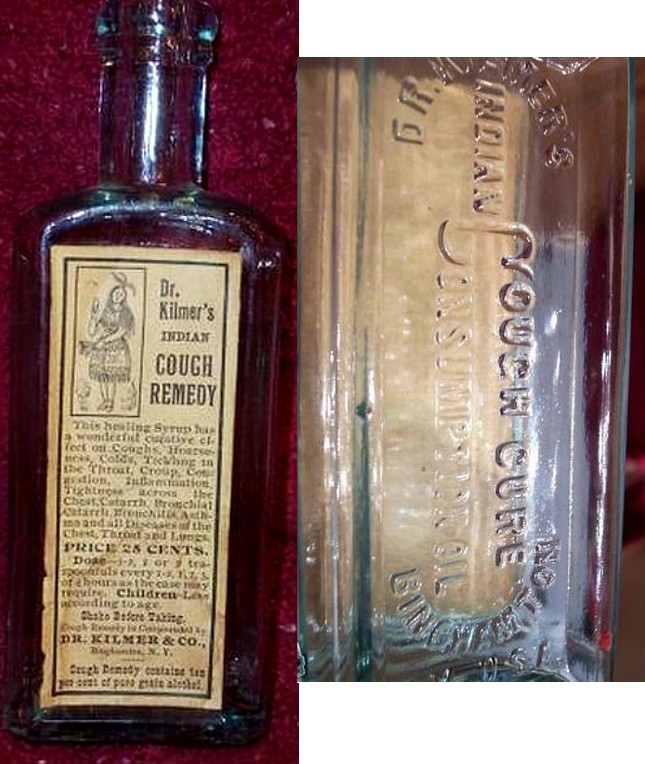Porter's Pain Cure / W.L. Porter Lima, O. embossed medicine bottle, circa 1870s.Embossed
Porter's Cure of Pain, Cleveland O. bottle.
This
Rundle Co.'s Porter's Pain King bottle is in the
Smithsonian (but not on display). [
Source]
These later Rundle's Porter's Pain King bottles are pretty common without labels. Even the paper-labeled bottles don't go for much. It appears that most of the earlier Cleveland bottles, unlabeled, are also readily available, and don't go for much either.
[Ebay completed listings.] The knowledgeable collectors on the
antiquebottles.net forum say "
The Bundysburgh early pontil marked ones are the most rare ones." Makes sense.
As a Lima bottle collector, I know the middle-Porter-era embossed Lima O./Porter's Pain Cure bottles are not common. And I'm still on the lookout for one with a paper label.
So, there are at least 4 different bottles all with Porter's name and different towns: Bundysburg, Cleveland, Lima, and Piqua. There are probably embossing and label variations. When/if I come across more photos, I'll add them.
But who is Porter?
Will The Real Mr. Porter Please Stand Up?!
In 1871, W.L. Porter sold his secret formula for Porter's Pain Cure to
G. H. RUNDLE, who changed the name to
Porter's Pain King when he (Rundle) set up production in Piqua, Ohio.
More about Rundle below, but let's focus on
W.L. Porter first:
"W. L. PORTER, coal and oil merchant, Lima, was bornSeptember 15, 1832, in Washington County, Penn., son of William and Jane (Langan) Porter, of Pennsylvania, and a grandson of John Porter, who came from Ireland to America in 1770.
His father, William Porter, who was a miller by trade, came with his family to Ohio in 1836, settling in Parkman Township, Geauga County, where he died in 1852. William Porter's wife died in 1834 in Washington County, Penn. They were parents of three children now living: Elizabeth, John and W. L. [William]
Our subject was educated in Geauga County, Ohio. He was for several years successfully engaged in the patent medicine business.
He was twice married, on the first occasion in I860, to Emma Harley, by whom he had one child—William Harley. Mrs. Porter dying in 1865, Mr. Porter remarried in 1873, Viella, daughter of B. P. Holmes, one of the early settlers of this county, and by her he has one child—Jane. [Harley lived in Cuba when Viella remarried after W.L.'s death.]
Our subject came to Lima in 1870 and engaged in the drug business, and in 1872 he sold out his drugs and commenced the coal and oil trade, in which he now does a large business.
He is a F. & A. M., a member of the lodge at Lima." [
Bio source]
This may or may not be our W.L. Porter, in 1863:
"Lieut. W. L. Porter, Fifty-sixth Ohio Volunteers, and Lieut. James K. Reynolds, Sixth Ohio Volunteers, are announced as acting aides-de-camp to the general commanding, and will be respected accordingly.By command of Major General Rosecrans" -- [Source] THE WAR OF THE REBELLION: A COMPILATION OF THE OFFICIAL RECORD OF THE UNION AND CONFEDERATE ARMIES.
Porter's Cure of Pain was sold to soldiers during the Civil War, according to CIVIL WAR -
The Encyclopedia of Cleveland History: "
Drugstores offered bottles of Porter's Cure of Pain to rid soldiers of stomach ailments."
Also in 1863:
"
Wm. L. Porter, proprietor of
Porter's Cure of Pain has removed from Bundysburgh, in this County,
to Cleveland, where he has formed a co-partnership with M. D. Norris, under the name of
W. L. Porter & Co. The firm appears as "Wholesale and Retail Dealer in Proprietary Medicines, Porter's Cure of Pain and Washing Blue... 128 Detroit St." He resigned from his job as Bundysburgh's postmaster. [
Source]
I don't know why Porter left Cleveland to come to Lima in 1870. Here he engaged in the drug business, and in 1872 he sold out his drugs and commenced the coal and oil trade, amongst many other occupations...
In 1872, the
First National Bank of Lima was founded, with
W.L. Porter on the Board of Directors. [
Source]
Porter was also involved in newspaper publishing:
"The Daily Republican, now in its third volume, was issued August 15, 1882. It is a twenty-four column folio, well printed and edited. This office is controlled by the
Republican Printing Company, with Charles L. Long, Manager, and J. M. Windsor, Secretary.
W. L. Porter is a member of this company." --
History of Allen Cty. / The PressIn 1885,
W.L. Porter was part of the management team for the
Lima Iron Fence Company. [
Source]
In 1886-87,
Porter was President of the
Allen County Mutual Fire Insurance Company. [Source]
Porter also
sold his Lima oil business interests:
"A tourist going through the
Central Oil Company's plant on Pearl street, will find everybody busily engaged with plenty of work to do.
Since buying W. L. Porter's interests in the oil business, the Central has been constantly busy and their own business on the increase." --
The Lima News / Feb. 25, 1888In
1890, he was referred to in the Lima newspaper as "
Ex-Standard Oil Magnate".
In 1893, W.L. Porter was in a Masonic Lodge. --
Proceedings of the Grand Council of Royal and Select Masters ..., Issues 63-65
By Royal and Select Masters (Masonic order). Grand Council of the State of Ohio [Source]
On Jan. 16,1894, the Lima Daily Times ran this classified ad, saying:
"The Grocery Stock of W. L. Porter and Co. will be retailed at assignee's sale. The public is cordially invited to visit the store and see the line of goods to be retailed. The stock must be sold and prices will be low. Terms cash. Isaac S. Motter, Assignee."
When did he start a grocery business? No info found.
W.L. Porter was killed on October 17, 1896 in a gruesome assault: "Fatally Assaulted on the Street. Lima. Ohio, October 17. W. L. Porter, a prominent citizen, was assaulted, knocked down and his skull crushed on the street last night, presumably by robbers. The assailants are unknown." [
Source]
W.L.Porter's widow remarried in February 1901, and the wedding announcement said
Porter had passed a few years earlier. I have not found his obituary yet.
"At 2 o'clock this afternoon a quiet happy nuptial event which was of unusual interest in Society circles ocurred at the home of the bride, at Market and Cole Streets. The groom the Hon. George P. Waldorf, of Toledo, present Internal Revenue Collector for the northern district of Ohio and his bride was Mrs. Viella H. Porter, widow of the venerable William L. Porter, whose death occurred in this city a number of years ago." [
Source]
About G.H. Rundle:"The manufacturer of this valuable article is G. H. Rundle, who was born in Westchester Co., N.Y., in 1847; he led the usual life of a farmer's son, and obtained his education in the common schools of his native State;
in 1871, he emigrated West, locating in Lima, Ohio, where he purchased the right of W. L. Porter to manufacture the Pain King; he was soon duly engaged in the chemical compounds, where he remained until five years ago, when he located in Piqua, Ohio, and now is filling large demands for his medicine; he has erected a complete laboratory, where he engages considerable assistance." [
Source]
Rundle's company is now called Porter's Products, and is still in business: "The original name was changed from Porter's Pain King Salve to its current name, due to a request from the FDA. The reference to liniment was made because
this salve was formulated from the Porter's original product, liquid Porter's Liniment." [
Source]
Notes:
- From 1886 to 1900, the Lima Oil Field was the leading producer of oil in the world. [Source]
- At the onset of the 1880s, Standard Oil was known only as a refiner. Thanks to the Lima discovery, Standard would be the leader in crude oil production in the 1890s. [Source]
- All the independent Lima area and other Ohio oil businesses eventually merged or soldout to become part of Rockefeller'sStandard Oil Company.
- By 1885, there were, or had been, 17 Lima newspapers: Herald, Porcupine, Argus, Reporter, Western Gazette, Gazette, Daily Gazette, People's Press, Democrat, Sun, Moon, Allen County Republican, Daily Republican, Volkeblatt, Courier, Democratic Times and Daily Times. [Source]
_______________
Originally published as part of my Lima, Ohio history ''virtual museum'' on my 'Tique Talk blog @ msdowantiques.com 











































































































